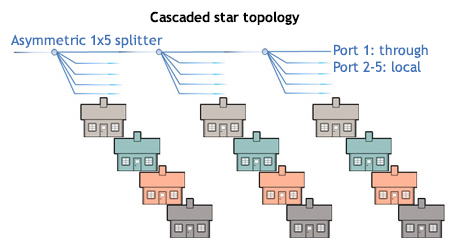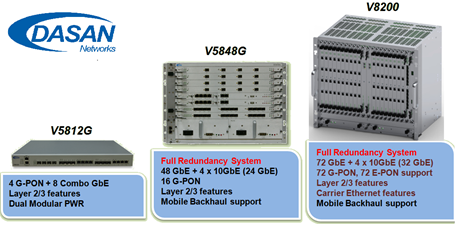With the growing subscriber needs for bitrate and popularization of optical access networks, the number of modern fiber optic networks in rural and other sparsely populated areas grows rapidly. Contrary to the popular belief, the peculiarity of such investments and requirements for them are different than those for typical FTTH networks constructed in multi-family dwellings.
The key factor is the choice of passive infrastructure system. For this, a technical partner with an adequate knowledge and a wide variety of solutions is necessary because there is no solution optimal for every situation. Fibrain company offers 7 basic passive systems. With possible modifications, the number of available solutions is much higher. As the only integrator offering complex FTTH systems in Poland, we are a fiber-optic cable manufacturer, therefore we are sure that the systems produced by us are optimized and thoroughly prepared. Examples of passive infrastructure systems which have been successfully used for FTTH network construction in sparse housing conditions are:
1. AIRTRACK – a suspended system based on ADSS type cables, uses the existing poles (e.g. electrical power)
2. BURRY-DAC – a system of cables laid directly in the ground, led to the subscriber’s house by a culvert
3. METROJET – a microdrain system used to increase installation technical capacities by applying micropipes
However, besides the infrastructure system, just as important is the choice of adequate network topology. An incorrect topology leads to additional costs, both capital and operational, due to network maintenance and service. While in the case of FTTH networks in multi-family dwellings, topologies which use symmetrical, centrally located splitters with many ports are usually the most optimal, in the case of a network in a rural area the answer is not so obvious. This is due to the fact that the distances between subscribers are large, and so is usually the distance to the central point, in which central devices such as a GPON OLT or a CATV receiver and an optical amplifier are placed. All this means that incorrectly chosen and misplaced splitters can significantly increase the cabling cost, which is an important part of the cost of the whole system. From another point of view, each distribution point also generates certain costs, therefore network topology cost optimization is not an easy task and it requires great experience and having adequate economical models for designing. Fibrain as one of a few companies in Poland has a design team which assists out Customers and helps choose the proper solution and topology as well as approximate the costs.
Very often while analyzing designs of FTTH networks for sparse housing conditions it appears that in is worth to use asymmetrical splitters. The aforementioned symmetrical splitters, which are popular in multi-family buildings, have nominally the same attenuation at each output port, e.g. an ideal 1x4 symmetrical splitter would have 25% of input power on each output port, so it would have an attenuation of 6 dB (of course due to technological reasons, there are differences between attenuations of the ports, and in addition a part of the power is lost on excess losses, so the maximal loss and attenuation uniformity are extremely important splitter parameters). Symmetrical splitters are ideal for multi-family housing areas, where about a dozen of subscribers are connected in one building to one distribution point. This is a typical star topology.
In sparse housing conditions, large distribution points that use symmetrical splitters are often uneconomical, and asymmetrical splitters are often used instead. The asymmetrical splitters are used to connect only a few local subscribers (single family houses). In such splitters, the output ports have different attenuation (different percentage of input power). Of course, 1x2 asymmetrical splitters are most frequently encountered. Fibrain as one of a few companies in Europe produces asymmetrical 1x2 splitters with any power split from 1/99% up to 49/51%.
In FTTH networks in sparse housing conditions, asymmetrical splitters with more ports are also often used. One of these ports is a selected transit port (with low attenuation), while the others are equal local ports. Using asymmetrical splitters gives the designer and investor more flexibility in planning the node points, allows to spare fiber and decrease network costs.
By using 1x2 asymmetrical splitters, building FTTH networks (also FTTB networks in cities) in bus topology is also possible. It is an economically proven solution mostly in the case of really sparse housing, although, as it was mentioned, it is also used for building FTTB networks in cities, if only one optical fiber is available and many buildings have to be connected. When designing such a network, it is worth to turn to an experienced specialist who will help calculate the required power split indices for each cascaded splitter.

 Asymmetrical splitters with a larger number of ports are used for network construction in cascaded star topology. It is more frequently used and often is the cost optimal solution in many rural areas.
Asymmetrical splitters with a larger number of ports are used for network construction in cascaded star topology. It is more frequently used and often is the cost optimal solution in many rural areas.
Fibrain company designs and manufactures asymmetrical splitters in any configuration adapted to a given investment scenario. As the only company in Poland, we have introduced asymmetrical 1x5 splitters in PLC technology characterized by very small casing dimensions. In asymmetrical 1x5 PLC splitters, port 1 is the transit port and can transfer up to 75% of total power, while ports 2-5 are local low power ports. This is the only such solution available on the Polish market. A version with a monitoring port, where port 1 has a very low power, is also available.
 Fibrain offers full designing and technical support (including help with power budget calculations), which also covers cost optimization of a proposed solution (with a comparison of alternative solutions). This way, the investor is ensured that the chosen solution is indeed optimal.
Fibrain offers full designing and technical support (including help with power budget calculations), which also covers cost optimization of a proposed solution (with a comparison of alternative solutions). This way, the investor is ensured that the chosen solution is indeed optimal.
But of course a passive network, even built the best way, is not enough for the operator to provide telecommunication services. Active devices of both central and subscriber type are also necessary. Fibrain cooperates with the main world’s manufacturers in this area. We are technical partners and exclusive distributors of Dasan Networks and BKtel. Dasan networks is the fourth world’s manufacturer of active GPON equipment, and only in Poland we have had about 80 implementations. The OLT (Optical Line Terminal) portfolio contains four different types of central units, from 1U “pizza box” type units to large modular ones. Six types of ONT (Optical Network Terminal) subscriber devices are also offered, so every operator can find something adequate to their needs.
In the case o f providing television services by an operator, FTTH networks offer a lot of possibilities – the CATV technology which uses a dedicated wavelength (usually 1550 nm, or the so-called RF overlay, but it can also be 1310 nm) allows to transmit television in PAL, DVB-C, DVB-T, or even DVB-S formats. We also offer optical CATV equipment produced be a renowned German company BKtel, who also manufactures models dedicated to FTTH networks. A great example can be the central hybrid BKtel AOT16200 device, which integrates a CATV 1550 nm receiver and a 16-port 16x20 dB optical amplifier. The amplifier enables connecting more than 2 thousand subscribers with a 1x128 split. The cost per subscribers is in this case a few euros!
f providing television services by an operator, FTTH networks offer a lot of possibilities – the CATV technology which uses a dedicated wavelength (usually 1550 nm, or the so-called RF overlay, but it can also be 1310 nm) allows to transmit television in PAL, DVB-C, DVB-T, or even DVB-S formats. We also offer optical CATV equipment produced be a renowned German company BKtel, who also manufactures models dedicated to FTTH networks. A great example can be the central hybrid BKtel AOT16200 device, which integrates a CATV 1550 nm receiver and a 16-port 16x20 dB optical amplifier. The amplifier enables connecting more than 2 thousand subscribers with a 1x128 split. The cost per subscribers is in this case a few euros!
To obtain more technical information about our passive and active FTTH solutions, please contact your local sales representative or email us at info@fibrain.com.
- Optical Transmission Lexicon: CATV, CWDM, DWDM, FTTH
- PON Technology-Based FTTH Networks for GPON Transmission
- FTTH Networks in Rural Areas and Sparse Housing Conditions
- CATV in FTTH networks
- CWDM Overlay for GPON Networks
- Passive CWDM Solutions
- Passive DWDM solutions
- Multimode GPON Transmission System
- Multimode CWDM Transmission
- Selective Wavelength Filters for Applications in Next Generation Access Networks
